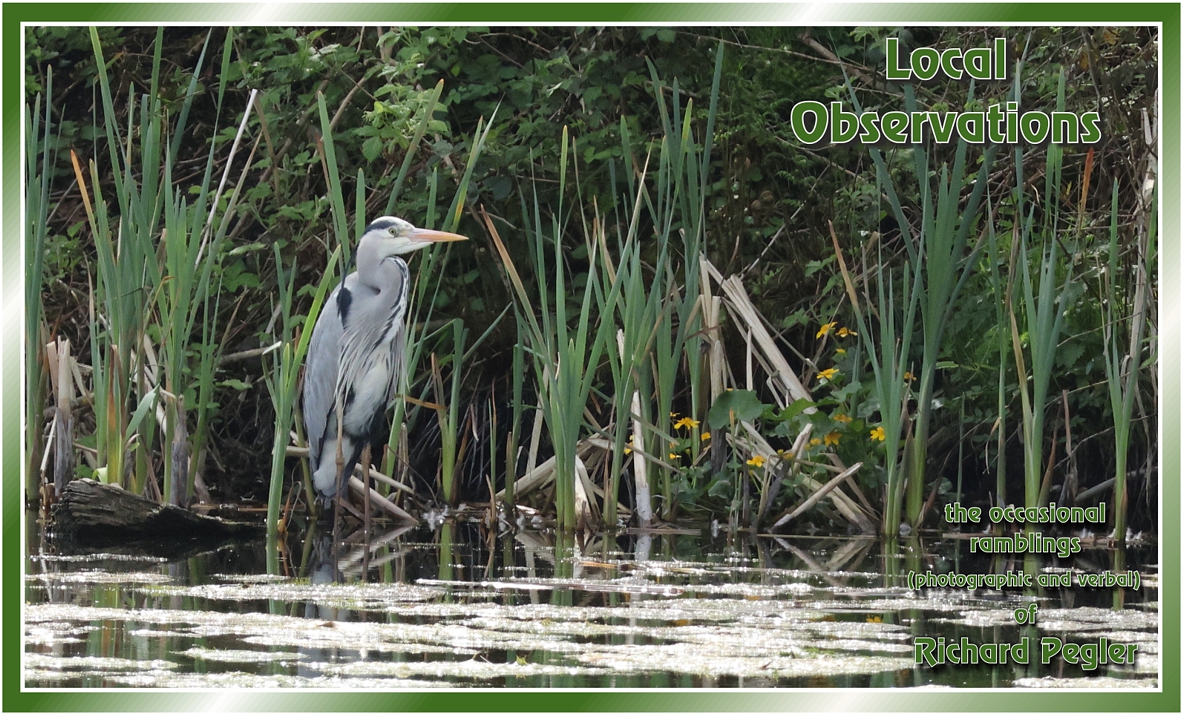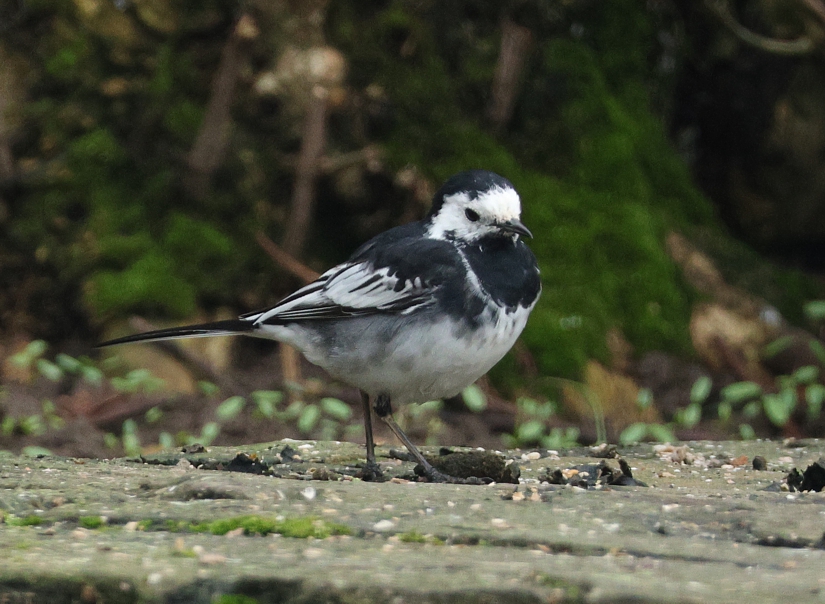Much of my time so far this year, as in the latter part of 2023, has been spent on domestic duties, having to take on much of Lindsay's share, due to her relative incapacity. Towards the end of the month, I started to feel that I needed to get out more, if only for short spells, in order to regain some of my sanity. This resulted in me visting four local locations on three separate days. At no time was I away from home for more than two hours.
The first part of this period resulted in sightings of very common species. However, things warmed up a little in the last few days of January.
Monday, 22nd January Garden
Although we had the pleasure of Siskin and Blackcap females visiting this day, the only photos I took were of a Blackbird. Although a common species, we have seen a worrying decline over the past couple of years in the numbers of this bird visiting our garden. This female is on the edge of our birdbath, before taking a drink.
 |
Blackbird (Turdus merula) (female) - our garden
|
Friday, 26th January Garden : Saltersford Valley Country Park : Oakthorpe
The Siskin and Blackcap were still with us but, again, no photos. I did, however, manage to grab a few shots of a Wren from my study window. As you can see, it had been a while since I last tidied up the garden!
 |
Wren (Troglodytes troglodytes) - our garden
|
That afternoon, I took some time out, heading to Saltersford Valley Country Park. On my previous visit, I had found the boardwalk section of the area closed off, due to flooding. I was disappointed to find this area was still closed off - with no reason visible. I did take a walk round the remainder of the area that was open and saw very little of interest, only photographing a confiding Robin, and a distant Coot.
 |
| Robin (Erithacus rubecula) - Saltersford Valley CP |
 |
Coot (Fulica atra) - Saltersford Valley CP
|
Being a little dischuffed with my visit to Saltersford Valley, and having only been out for a short while, I set off to visit the nearby location, by Oakthorp, where I'd recently seen the Yellow-browed Warbler and more recently photographed Fieldfare, in the hope of getting better Fieldfare images. I only saw one Fieldfare in the distance, which fled when a couple with a dog passed by it. I did, however, spot a Goldcrest, and spent about half an hour trying to photograph it, but failing miserably. The best that I could do was get a couple of record shots of it in flight.
 |
Goldcrest (Regulus regulus) - near Oakthorpe
|
It was then time to head back to Lindsay, only 10 minutes away.
Saturday 27th January Donisthorpe Woodland
The following day I paid a short visit to Donisthorpe Woodland, just down the road from home. Part of this area is alongside a now isolated section of the old Ashby Canal. I passed alongside the canal for a while, only spotting a Mallard on the far side of the canal and a Great Tit in the edge of the woodland, opposite the canal.
 |
Great Tit (Parus major) - Donisthorpe Woodland
|
 |
Mallard (Anas platyrhynchos) (male)
|
I then took a circuitous route which took me along the edge of the Moira Furnace site, and then back to my car. I saw disappointingly little during my walk, only stopping to photograph some teazels, a Blackbird, and another Great Tit, which I shan't bother you with here.
Teasels are the dead flowerheads of plants of the genus Dipsacus. They are still used by some people for carding wool but, for me, they are an architecturally atractive plant
 |
Teasel (Dipsacus sp.) - Donisthorpe Woodland
|
 |
Blackbird (Turdus merula) (male) -Donisithorpe Woodland
|
Sunday, 28th January Garden : Longmoor Lake
This was a good day for visits by birds to our garden, with 18 species setting a foot down. These included 8 Long-tailed Tits - always fun to watch.
 |
Long-tailed Tit (Aegithalos caudatus) - our garden
|
Most exciting, however, was the appearance of a Reed Bunting. We last saw this species in the garden in February 2023, when a female visited. These shots were taken from my studty window.
 |
Reed Bunting (Emberiza schoeniclus) (male) - our garden
|
That afternoon, I made a quick visit to Longmoor Lake. This lake is situated in the Queen Elizabeth II Diamond Jubilee Wood, which is close to our home. In the early days of this wood, when the trees were mere saplings, the area was good for birds, including Barn Owl and Tawny Owl. However, the trees have grown rapidly, and are so densely placed that it seems to have made it unattractive to the birds. I saw virtually nothing until I reached the lake, some one and a half kilometres from the car park.
I spent a few minutes in the hide and saw that Canada Geese and Greylag Geese were there in good numbers, as were Wigeon. I took some photos from the hide but didn't stop long as my time was limited.
 |
Canada Goose (Branta canadensis) - Longmoor Lake
|
 |
Greylag Goose (Ansa ansa) - Longmoor Lake
|
I then walked to the far end of the lake, taking a few more photos as I went.
 |
Wigeon (Anas penelope) (male + female) - Longmoor Lake
|
I went a little beyond the far end of the lake, before turning back. Immediately I did so, some Long-tailed Tits moved through the hedge beside me. The light was poor, but I did manage a shot that is just about useable.
 |
Long-tailed Tit (Aegithalos caudatus) -by Longmoor Lake
|
On the way back, dusk was beginning to fall. I photographed an immature Mute Swan that looked as if it was hoping that I'd feed it, but it soon gave up.
 |
Mute Swan (Cygnus olor) (immature) - Longmoor Lake
|
It was that time of the afternoon when the geese decide that it is time to return to their night roosts. There is plenty of warning when this is going to happen as their calls build up to a very noisy crescendo before they take off in groups.
 |
| Canada Goose (Branta canadensis) - Longmoor Lake |
I took a shorter route back to my car, arriving home at the expected time.
Tuesday, 30th January Staunton Harold
It was only two days before I managed another brief trip out, prompted by a report of a Cattle Egret in a pasture with sheep, opposite the hall at Staunton Harold, and less than ten minutes from our home.
Having parked my car, I walked up the road past the sheep pasture, and a little further, before turning back without seeing the egret. Arriving at the public footpath that leaves the road and goes uo the hill through the pasture, I decided to give it a try in case the bird was skulking over the brow of the hill - it wasn't.
As I descended on this footpath, I scanned over the nearby lake, looking at the swans and gulls that were on the grass on the far side of the lake - and there, to my surprise, was the egret, at the water's edge, in a position where it would be clearly visible from the road that leads to the hall.
As I crossed the causeway between the two lakes, I took a shot of a Coot.
 |
Coot (Fulica atra) - Staunton Harold
|
A little further on, the road takes a curve to the right that brings it closer to the lake, and the egret was clearly visible from there. I got in quite a few shots before it decided to return to where it had originally been seen - the sheep pasture. You may be able to detect that this bird is showing a hint of colour on the forehead - the start of breeding plumage.
 |
Cattle Egret (Bubulcus ibis) - Staunton Harold
|
Given more time, I would have walked up the road to take some photos of it in the sheep pasture, but I needed to get back to base to check that all was OK with Lindsay.
No photography was attempted on the last day of the month, although we had a good number of birds visiting the garden.
Currently, I have no idea when my next blog post will be as we have a plethora of medical visits coming up in the next fortnight, culminating, if all goes to plan, with Lindsay having a second replacement knee on 12th February. I can see that I'm going to be rather busy for a while!
In the meantime, please take good care of yourselves and Nature. Thank you for dropping by - - - Richard









































































